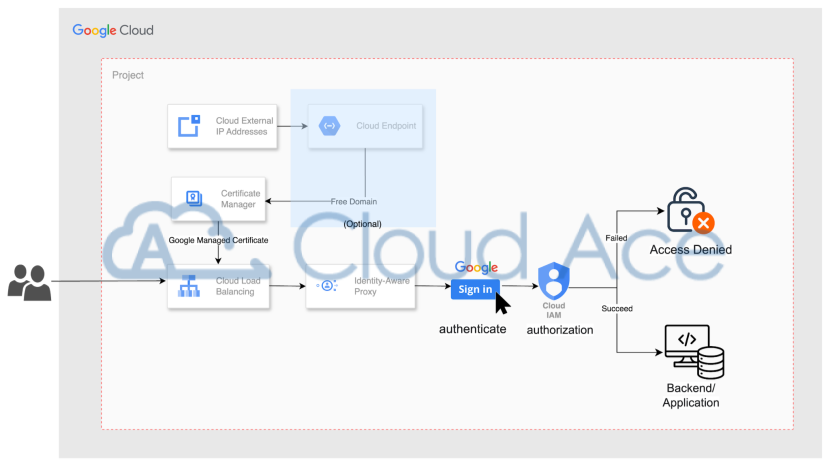文章段落
資安防護一直是雲端服務中大家非常重視的一塊,而 Google Cloud 除了有最基礎的安全防護(例如:防火牆)之外,也推出了一系列零信任的服務來保護網站或應用程式,今天要介紹的 Identity Aware Proxy(後簡稱 IAP)就是其中一種,對企業來說是可以利用 Identity and Access Management (IAM) 加強保護敏感應用和數據的重要技術,現在就一起來了解 IAP 的厲害之處吧!

測試環境架構圖,Cloud Endpoint 為選擇項目,以使用 Google 免費域名做示範
IAP 介紹:
IAP 是什麼
IAP 是一種零信任的安全服務, 主要用於保護企業的應用程式,它會假設所有的網絡流量都是不可信任的,所以所有用戶都需要進行身份驗證和授權,才能訪問特定的網站或應用程式。你可以把它想像成一個警衛,只會讓有識別證的訪客進入。
IAP 3 大特點和優勢
- 安全性:IAP 確保只有經過認證的使用者才能訪問你的應用程式或網站,防止未授權的訪問。它為應用程式添加了一層額外的保護,不管應用程式本身的安全性如何。
- 簡單管理:管理使用者的訪問權限非常簡單,即使你的應用程式分佈在多個服務器或不同的地點,IAP 也可以讓你在同一個介面統一管理誰能進入應用程式。
- 集成方便:IAP 可以輕鬆與 Google Cloud 的其他服務集成,提供一個無縫的體驗。它使用現有的 IAM,所以使用者不需要額外的權限管理系統。
IAP 與其他安全軟體的差異
- 傳統的 VPN(Client To Site):傳統 VPN 需要使用 VPN tunnel 連接到公司內網,可能因地理、網絡等影響導致用戶體驗不佳。而 IAP 可以直接保護應用程式,只需登錄一次即可訪問所有授權的應用程式。
- 防火牆:防火牆通常在 OSI 模型第三層進行流量篩選,而 IAP 除了在第七層保護應用程式外,還解決防火牆通常無法區分使用者身份的問題,提供更精細的控制。
- 傳統的身份認證系統:傳統的身份認證系統可能需要每個應用程式都實現自己的身份驗證邏輯,而 IAP 提供了統一的身份認證系統,簡化多個應用程式的身份管理。
IAP 實作-部署到驗證步驟教學:
接著就來實際操作看看 IAP 的相關設定吧!在這個教學中我們將展示如何利用 Google Cloud 的 IAP 來實現零信任安全模型,為雲端工作負載提供更強大的安全保護。
建立並設定測試環境
步驟一:建立環境
- 在 Cloud Console,左側目錄點選 Compute Engine>Instance Templates.
- 點擊上方 Create an instance template,除了以下設定其餘皆保持預設設定:
- Firewall:
- 允許 HTTP traffic
- 允許 HTTPs traffic
- 點選 Management, 下拉選單點選 Automation>Startup script,填入以下的開機腳本,它會建立一個簡單的網頁:
- Firewall:
#!/bin/bash apt-get update apt-get install apache2 -y echo "hello! CloudAce" | tee /var/www/html/index.html systemctl restart apache2
©2024 Google
3. 點選下方 CREATE,建立 Instance Templates,完成後顯示如下圖。
©2024 Google
步驟二:建立 Health Check,檢查後端服務的健康。
- 在 Cloud Shell 中輸入以下 gcloud command 指令以建立允許 Health Check 探針流量的防火牆規則:
©2024 Google
gcloud compute firewall-rules create allow-health-check-fw --direction=INGRESS --priority=900 --network=default --action=ALLOW --rules=tcp:80 --source-ranges=130.211.0.0/22,35.191.0.0/16
©2024 Google
2. 在 Cloud Console,左側目錄點選 Compute Engine>Health Checks
3. 點擊上方 Create Health Check ,輸入以下資訊:
- Name:my-health-check(可自行決定名稱)
- Protocol:HTTP
©2024 Google
©2024 Google
步驟三:建立 Managed Instance Group,做為稍後建立 Load balancer 的 Backend,讓 VM 可以被自動化管理
- 在 Cloud Console,左側目錄點選 Compute Engine>Instance Groups.
- 點擊上方 Create instance group,除了以下設定其餘皆保持預設設定:
- Name: my-managed-instance-group.(可自行決定名稱)
- Instance template:選擇步驟一建立的 instance template
- Location: Multiple zones.
- Region: us-central1
- Autohealing:
- Health Check:選擇步驟二建立的 my-health-check
©2024 Google
©2024 Google
申請託管憑證,並完成負載平衡設定
步驟四:利用 Cloud Endpoints 取得免費域名(如果已擁有域名,可以直接跳至步驟五)
- 使用 gcloud command 保留一個 global IP Address,並記下 IP Address 以便稍後使用
gcloud compute addresses create my-ip --project=[Your Project ID] --description=for-iap-labs --global # 保留一個global IP Address gcloud compute addresses describe my-ip --global #Print 出 IP Address 的資訊
©2024 Google
2. 點擊上方 Create instance group,除了以下設定其餘皆保持預設設定:
A. Name: my-managed-instance-group.(可自行決定名稱)
cat << EOF > enpointdns.yaml
swagger: "2.0"
info:
description: "Cloud Endpoints DNS"
title: "Cloud Endpoints DNS"
version: "1.0.0"
paths: {}
host: "[Your Sub Domain].endpoints.[Project ID].cloud.goog"
x-google-endpoints:
- name: "[Your Sub Domain].endpoints.[Project ID].cloud.goog"
target: "[Your IP Address]"
EOF
# 這裡將 Domain 設為:iap.endpoints.[Project ID].cloud.goog©2024 Google
3. 在 Cloud Shell 執行以下 gcloud command 部署 enpointdns.yaml:
# gcloud endpoints services deploy enpointdns.yaml
©2024 Google
©2024 Google
步驟五:在 Certificate Manager 中申請託管憑證
- 在 Cloud Console,左側目錄點選 Security>Certificate Manager.
- 點擊 Classic certificates 後,點擊 Create SSL certificate 建立託管憑證,輸入以下資訊:
- Name:my-managed-certificate(可自行決定名稱)
- Create mode:點選 Create Google-managed certificate
- Domain:iap.endpoints.[Project ID].cloud.goog
- 點擊 Classic certificates 後,點擊 Create SSL certificate 建立託管憑證,輸入以下資訊:
©2024 Google
©2024 Google
步驟六:建立 Load Balancer
- 在 Cloud Console,左側目錄點選 Network Services>Create a Load Balancer,點擊上方 Create a Load Balancer,選擇 Application Load Balancer(HTTP/S), 點擊 Start configuration.
- 選擇 From Internet to my VMs or serverless services 和 Global external Application Load Balancer ,點選 Continue
- 輸入名稱:my-load-balancer(可自行決定名稱)
- 點擊 Frontend configuration,除了以下設定其餘皆保持預設設定:
- Protocol:HTTPS
- IP Address:選擇先前建立的 my-ip
- Certificate:my-managed-certificate
- 點擊 Done,完成 Frontend 的新增
©2024 Google
3. 點擊 Backend configuration, 點選 Backend services & backend buckets>Create a backend service,除了以下設定其餘皆保持預設設定:
A. Name: my-managed-instance-group.(可自行決定名稱)
3. 點擊上方 Create instance group,除了以下設定其餘皆保持預設設定:
A. Name:my-backend-service.(可自行決定名稱)
B. Instance group:my-managed-instance-group
C. Port:80
D. Cloud CDN:Disable (CDN 預設開啟,和 IAP 無法共同啟用)
E. Health check:選擇剛建立的 my-health-check
F. 點選 Create,完成 backend service 的新增
©2024 Google
©2024 Google
4. 點擊下方 Create,完成 Load Balancer 的建立
截圖自:Chrome 瀏覽器頁面
©2024 Google
設置與驗證 IAP 防護
步驟七:啟用 Identity-Aware Proxy API 並設定 OAuth consent screen
- 在 Cloud Console,左側目錄點選 Security>Identity-Aware Proxy ,選擇您的 Google Cloud Project
- 點擊 Enable API
- 設定 OAuth consent screen :
- 在 Cloud Console,左側目錄點選 APIs & Services>OAuth consent screen,輸入以下設定:
- User Type:選擇 External,點擊 Create
- 在 Cloud Console,左側目錄點選 APIs & Services>OAuth consent screen,輸入以下設定:
©2024 Google
ii. Application name:my-web(可自行決定名稱)
iii. User Support email:填入您的 email
iv. Developer contact information:填入您的 email
B. Name:my-backend-service.(可自行決定名稱)
©2024 Google
©2024 Google
©2024 Google
步驟八:為網站啟用 IAP 防護並添加 principals 到 IAP 的允許清單
- 回到 Security>Identity-Aware Proxy 頁面,點選 Applications.
- 開啟 my-backend-service 的 IAP 開關
©2024 Google
4. 點選 Turn on.
©2024 Google
6. 填入以下資訊,賦予可通過 IAP 防護的權限
- New Principals:輸入您的 user account email
- Role:IAP-secured Web App User
7. 點選 Save
©2024 Google
步驟九:驗證 IAP 是否設置成功
- 開啟無痕瀏覽器輸入 https://iap.endpoints.[Project ID].cloud.goog/,驗證請求轉發到 Google 的登入畫面進行身份驗證,即設定成功。
截圖自:Chrome 瀏覽器頁面
©2024 Google
結論
看完這次對 Gateway API 的介紹和相關功能的實作教學後是不是對 Gateway API 其他用途更有興趣了呢!如果對 Gateway API 服務上還有任何想了解的內容,歡迎聯絡 Cloud Ace 獲得更進一步的資訊。



![[GCP 資安攻略] GCP 資訊安全各項功能簡介](https://storage.googleapis.com/cloudace-tw-blog/1/2021/07/GCP-資安攻略-GCP-資訊安全各項功能簡介-300x157.jpg)

![[DDoS大作戰] BeyondCorp實作 – 設定 Cloud IAP 完全封鎖外部異常流量](https://storage.googleapis.com/cloudace-tw-blog/1/2021/01/部落格情境圖-20210121.png)